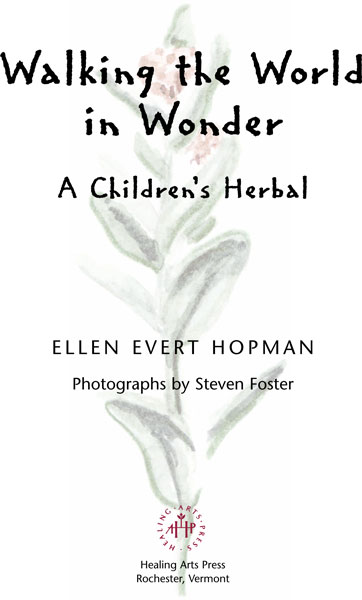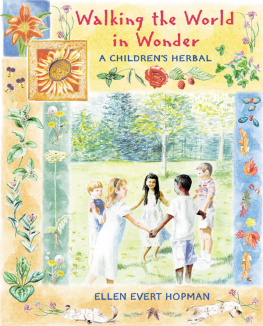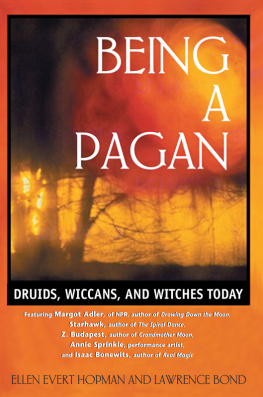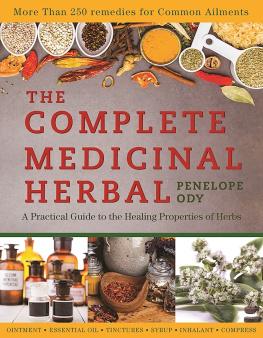

To the Earth and Her creatures; to the furry, feathered, scaly, skinned, finned, slimy, and many-legged ones, and most especially to the green nations and to the little people and those who love them.
CONTENTS
A NOTE TO PARENTS AND TEACHERS
This book is designed to encourage wonder. It can be used as a game whose object, like that of a scavenger hunt, is to find as many of the plants as possible, or it can be used as a field guide, a book to consult when you find yourself wandering through fields, woods, or gardens. Once upon a time, children would have learned about the many uses of plantsas food, as decoration, and most importantly, as medicinefrom their elders. A wisewoman or man who had learned the ways of the plants would have guided children as they discovered the natural world around them. Our world is very different now, but plants still have much to teach us. This book will introduce children to the beauty and power of the herbs that still grow all around usfrom rural fields or suburban yards to city parks and empty lots. The traditional medicinal uses for each plant are described along with suggestions for art projects, seasonal celebrations, and recipes.
Gathering Herbs with Your Child
Many of the projects in this book include making teas or edible treats from specific plants, tasks that will require guidance and supervision from an adult. If you and your child are new to the medicinal uses of herbs, you may want to enlist the assistance of a seasoned herbalist or gardener to help you identify plants. If you plan to use the herbs for edible or medicinal purposes, we suggest you purchase them from a reliable source, and reserve the herbs you gather for craft projects. Of course, you and your child should never ingest any herb if you are not sure that you have identified it correctly. As you gain experience with identifying herbs in the wild, you will be able to use what you gather yourself to treat minor ailments.
Using Herbs Safely
Some of the herbs mentioned in the book should not be ingested by children. Often there are safe medicinal uses for these herbs for adults, but they are not routinely recommended for childrens use. Entries that contain this symbol  indicate plants that should not be eaten!
indicate plants that should not be eaten!
The safety issues of herb use during pregnancy are beyond the scope of this book, which is geared toward children. Pregnant and lactating women should not use any of the herbs mentioned in this book without consulting an herbalist or an herbal especially designed for their unique needs.
Using Homemade Medicines
Most children are excited when they learn that the plants they see in their backyard or on their walk to school can help them feel better when they have a sore throat or bruised knee. Even fussy kids will be thrilled to take their homemade medicine with the addition of a little honey. But children should be taught that with the exception of very mild herbs (such as peppermint or chamomile, for example), many herbal teas are indeed medicines and not for daily use. Medicinal teas or preparations should be used occasionally rather than routinely; even safe herbs, like most substances, can cause side effects if taken frequently or in excess. Any serious ailments should always be brought to the attention of a health care professional. Unless an entry states otherwise, a childs dosage for a medicinal herbal tea is 1 cup per day, taken in cup doses (or sips, if indicated) between meals; adults can have up to 2 cups per day.
Hints for Small Hunters and Gatherers
Attention to a few key details will make your gathering experience safer and more satisfying. Because lead and emissions from cars tend to be concentrated in the soil near the roadsides, be sure that any plants you plan to consume are gathered at least 1,000 feet from any busy road or highway. Likewise, city lots and suburban lawns may have been sprayed with pesticides or fertilizers that can contaminate the plants growing there. Be sure that you do not consume any plants unless you are certain that they are free of chemicals. Any wild greens you gather should be soaked for 20 minutes in a gallon of cold water to which you have added 2 tablespoon of vinegar or salt. The soaking will remove any parasites or wild things clinging to the greens! Then they should be carefully washed and rinsed as usual.
Herbal identification was an integral part of childrens everyday education until very recent times. In this age of synthetic medicines that are often expensive and sometimes have harsh effects on the body, it is important that this knowledge be preserved and handed down to future generations. Powerful and nourishing healing agents are all around us in the garden, field, and forest. My hope is that this small volume will pass some traditional herbal wisdom on to children and inspire a lifetime of inquiry into the magic and beauty of the green world.
INTRODUCTION
Long before people bought medicine or food at a store, they learned to use the wild plants growing all around them. They watched animals to see which plants were good to eat and which plants were poisonous. They experimented and learned which plants could heal people when they were hurt or sick. People passed their knowledge on to their children and grandchildren for generations. This book will help you learn the names of many different kinds of plants and show you how they can be used for medicine, food, and fun.
Using this Book
On the next page is a checklist of some plants that you can find in the fields and forests of the northern temperate zone. The entries in this book will tell you the plants common namethe name in English that you will find in the checklistalong with its Latin name in parenthesis. Scientists always use Latin plant names to avoid confusion. Different countries, and sometimes different areas of the same country, use different common names for the same plant, but a plants Latin name is the same all over the world. There is also a photograph beside each entry to help you identify the plants you find. Many of these herbs have healing properties, but not all parts of all plants are good to eat, so be sure you use them only with the help of an adult. Have fun finding as many as you can!
Some plants are not good for children to eat at all. Do not eat the plant when you see this symbol  . Never eat any plant that you find on your own without asking an adults permission!
. Never eat any plant that you find on your own without asking an adults permission!
Making Your Own Herbal
You can make your own herbal catalogue of plants that you have collected and pressed. To do this, you will need an old phone book, some watercolor paper, and some clear, self-sticking shelf paper, which you can find in most craft or hardware stores. Gather your plants on a dry day, after the morning dew has evaporated. It is important that the plants be dry when you pick them. Carefully press the leaves and flowers in the old phone book. Phone books work well because the pages are so absorbent. Take your phone book with you on your field tripsyou never know when you might find a plant you have been searching for! When you get home, put your phone book on a table or countertop and place a heavy book on top of it (a dictionary is good). Let your plants sit like this for a week.
The plants are ready to mount when they still have their green color but are completely dry. This is importantif there is any moisture left in the plant, mold will form under the plastic. Take your pressed plant and place it on a sheet of watercolor paper. You might want to write the plants name on the bottom of the paper to help you remember it. Then cover the whole sheet of paper with a layer of clear, self-sticking shelf paper. Trim the edges of the shelf paper so that they are even with the edges of the watercolor paper. Plants preserved like this will keep their color for years.
Next page






 indicate plants that should not be eaten!
indicate plants that should not be eaten!